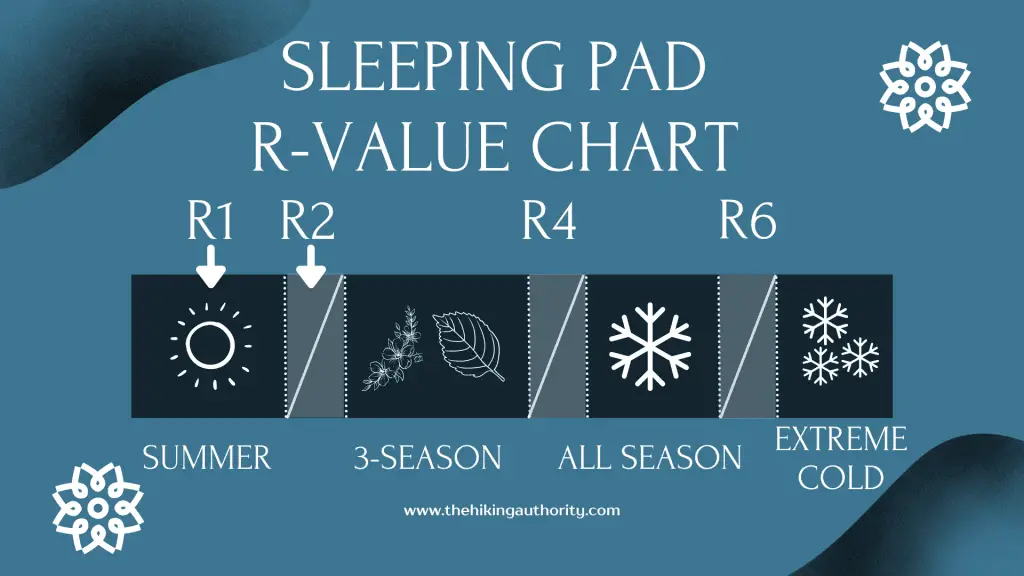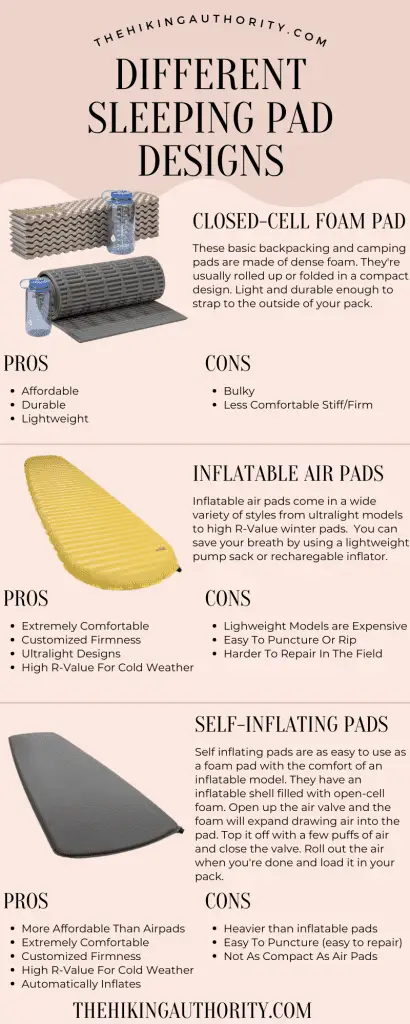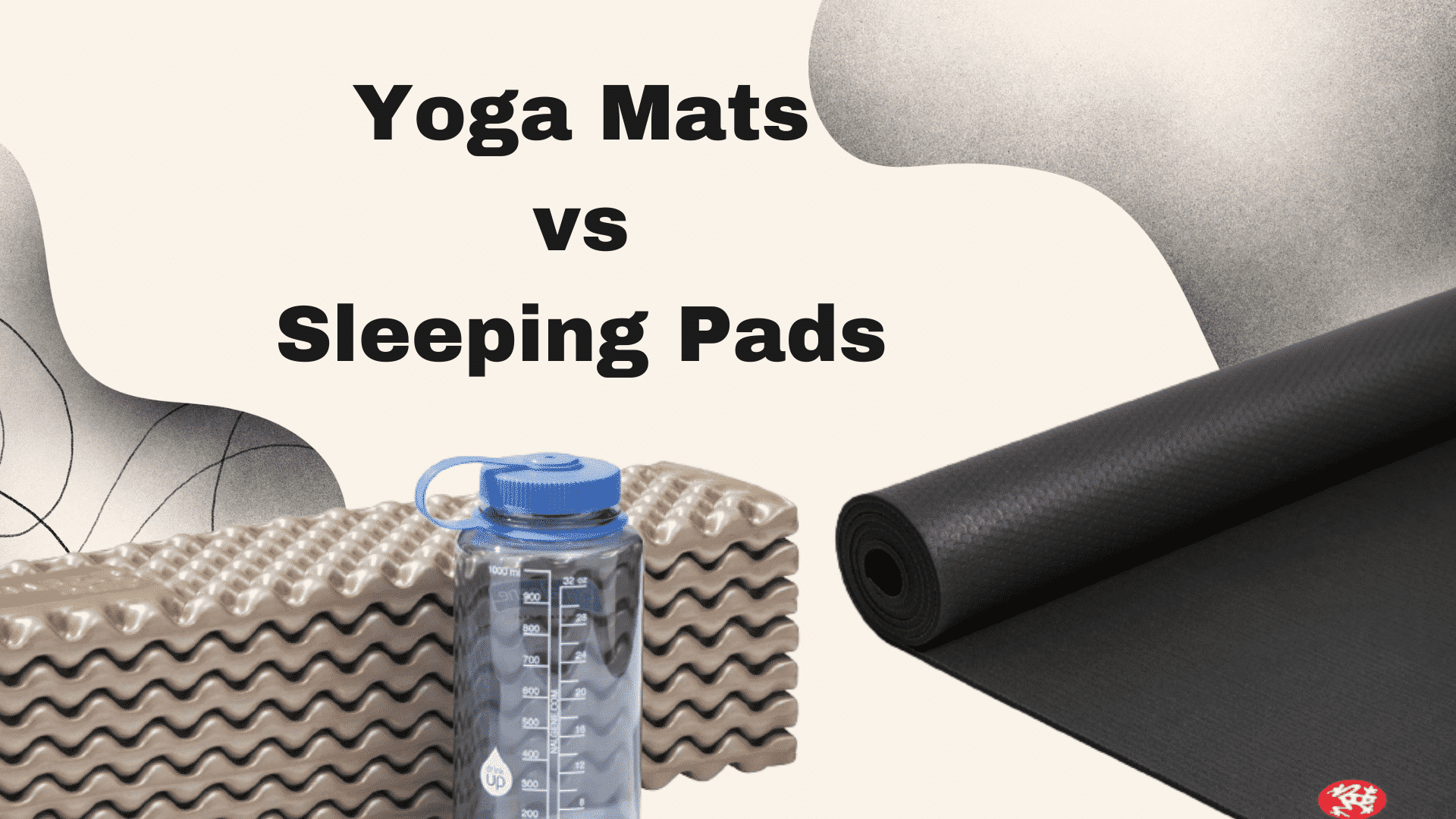We all need to make some sacrifices when picking out camping gear. Backpacking and camping can be an expensive hobby and most of us aren’t millionaires. Sometimes that means buying heavy gear that costs less and other times you try to make substitutions with things you have lying around the house. Some substitutions work and others are better left in the idea stage.
So is there any way to get around buying an expensive sleeping pad? Yoga mats look like they would be close to the same thing, but do they offer the same benefits of a sleeping pad? That leads to a simple question: can you use a yoga mat as a sleeping pad?
A yoga mat should not be used as a sleeping pad. A thick padded yoga mat might add a little bit of support/comfort below your sleeping bag, but it won’t offer insulation against the cold ground. This won’t be a big deal in the summer, but you will be freezing on cold spring/fall nights.
Sleeping pads and yoga mats might look similar, but they’re designed for different uses. You will be much better off with a proper sleeping pad that offers insulation against the cold ground. Even a basic Therm-A-Rest Zlite Pad (1.7 R-Value) or Therm-A-Rest Ridgerest Pad (2.0 R-Value) will be more comfortable than sleeping on a yoga mat.
I will explain sleeping pad R-Value Ratings, go over different sleeping pad styles, and give product recommendations at the bottom of this post. So make sure you read down to the bottom if you’re looking for a new sleeping pad. You might be surprised at how cheap some of the best pads are.
Using A Yoga Mat As A Sleeping Pad

Sleeping mats and yoga mats might look similar, but they’re completely different products. Yoga mats are fairly comfortable for doing yoga, but they don’t have the cushion and insulation for going under your sleeping bag. Real yoga mats are made out of rubber to provide grip while you’re going through your routine.
The rubber material will protect your bag from the ground, but it won’t provide the comfort/warmth of a real sleeping pad. Thicker foam stretching pads will work similarly to a foam sleeping pad, but they’re heavy and bulky to carry. It’s better than nothing, but it’s worth spending the extra $10-20 for a real foam sleeping pad.
It should be obvious that sleeping pads are meant to be slept on so they’re designed to increase comfort and insulation against the cold ground. Some pads are more comfortable than others, but a sleeping pad will always be better than using a yoga mat. Foam stretching mats are comparable to the comfort/insulation of a foam sleeping pad if you already have one lying around your house, but it will be heavier and bulkier to carry on a pack.
Here are a few reasons why you shouldn’t use a yoga mat as a sleeping pad.
- Uncomfortable: Yoga mats are comfortable enough for light exercise, but I wouldn’t want to sleep on them for an extended period of time. They’re usually made out of hard rubber or a thin piece of foam and I wouldn’t want to lay on one overnight. My yoga mat is only 1/8 of an inch thick and thinnest foam sleeping pad you’ll find is closer to 1/2 inch. Inflatable and Self-inflating pads will be closer to inches thick and provide way more comfort.
- Not Insulated: Inflatable/Self-Inflating sleeping pads are comfortable, but a closed-cell foam pad is a closer comparison to a yoga mat. Foam sleeping pads provide a little bit of cushion, but that’s not their primary purpose. They’re mostly used to insulate your body against the cold ground in chilly spring/summer/fall nights. Most foam pads have a 2.0 R-Value which is way more insulation than a yoga mat could provide.
- Bulky Design: Most yoga mats are made out of a rubber material so they can’t be rolled as tight as inflatable and self inflating sleeping pads. They do have a similar profile to foam sleeping pads, but they’re usually a few inches wider than regular sized pads. You might as well buy a cheap Thermarest Ridgerest Pad if you’re strapping a yoga mat to your pack.
- Heavier Weight: A typical foam sleeping pad weighs just under a pound, while my Manduka Yoga Mat weighs almost 7.5 pounds. That might not be a big deal if you’re camping out of a car, but it’s a major factor for backpackers.
Sleeping Pads vs Yoga Mat
- Sleeping Pads: Sleeping pads come in 3 different styles: foam, inflatable, and self-inflating. If you’re looking into using a yoga mat, you’re probably picturing a foam sleeping pad. Foam pads are cheap, extremely durable, and provide about 2.0 R-Value which makes them warm enough for 3-Season use. Self-Inflating and inflatable pads are more expensive, but they’re far more comfortable than foam pads. They have more cushioning and a higher R-Value for colder temperatures. I recommend pairing a foam pad with some type of inflatable pad if you plan on camping in cold weather.
- Yoga Mats: Most yoga mats are made out of thin rubber. The rubber material will protect your bag from the ground, but it won’t provide the comfort/warmth of a real sleeping pad. Thicker foam stretching pads will work similarly to a foam sleeping pad, but they’re heavy and bulky to carry. It’s better than nothing, but it’s worth spending the extra $10-20 for a real foam sleeping pad.
Foam Yoga Mats Are Similar To Foam Sleeping Pads

A traditional rubber yoga mat won’t offer much protection against the ground, but thick foam mats will add a little bit of insulation. Thick 3/4″ foam mats really aren’t meant for yoga since they have too much give below your fingers, but a lot of people confuse them with yoga mats.
Foam mats are designed for basic stretching (not yoga) since they’re slippery and your hands/feet will sink down into the padded surface. That’s horrible for yoga, but it does make them into a halfway decent sleeping pad. You will get the added comfort of a foam pad, but it’s hard to say what the R-Value would be.
If I were to take a guess, a foam mat would be close to R-Value 1.5, which is similar to the old school green military surplus sleeping pads. For comparison, a sheet of 3/4″ plywood has a 1.25 R-Value rating so it won’t offer much insulation, but it will be good enough in the summer.
The only problem is foam mats are bulky and heavy to carry. That’s not a big deal on a family camping trip out of your car, but it will be an issue if you’re backpacking. The foam yoga mat pictured above weighs 2.5 pounds, whereas a traditional backpacking foam sleeping pad is less than 1 pound.
You can’t beat the price of a cheap Therm-A-Rest Ridgerest Pad (2.0 R-Value) only weighs 14oz. Personally I prefer the Z Lite Model that’s the same weight with a slightly lower 1.7 R-Value, because it folds into a compact rectangle, but either pad would be better than a Yoga Mat.
Sleeping Pad R-Values Explained

Sleeping Pad R-Values always seem to confuse people. That’s why I decided to make the above chart explaining different R-Values to make it easier for you to choose a sleeping pad. Generally speaking, sleeping pads fall into 3 different R-Value ranges. Foam pads are usually close to 2.0 R-Value, inflatable/self-inflating pads 3-4.0 R-Value, and winter pads are 5+ R-Value.
Remember temperatures drop at night so you can’t base R-Value ratings on daytime temperatures. You need to think of the worst possible weather that could happen on your camping trip. Temperatures can drop fast with rain and windy weather.
Having too warm of a sleeping pad will add a little bit of weight to your pack, but it won’t make you any warmer than a lower rated pad for that’s more suitable to the temperature. Here’s a quick breakdown explaining different temperature ratings or you can check the graphic above or table below for more info.
- R-Value 0-1 (Hot Summer): The vast majority of unrated sleeping pads and military surplus pads fall into this range. Think about where military surplus pads were used, Vietnam, Iraq, Persian Gulf, etc (all hot climates). Most cheap pads provide very little insulation and only offer a small amount of padding from the hard ground. Only use an unrated pad in constantly warm summer air with consistent ground temperature.
- R-Value 1-2 (Late Spring, Summer, Early Fall): Most closed cell foam sleeping pads from Therm-A-Rest, Nemo, Mountain Equipment, Big Agnes, etc. fall into this temperature range. These pads are great for warmer weather from late spring to early fall. Once the nighttime temperatures drop below 50°F it’s time to buy a higher R-Value pad.
- R-Value 2-4 (Late Spring, Early Fall): This is the perfect R-Value range for 3-Season use. The vast majority of budget inflatable and self-inflating pads fall into this temperature range. You can stack sleeping pads for a higher temperature rating, so I recommend buying a self-inflating/inflatable pad in this range and pairing it with a foam pad if you want to camp in colder weather.
- R-Value 4-6 (Cold Spring/Fall/Winter): You can find premium/expensive inflatable and self-inflating pads in this R-Value range. There are a few budget options like the Sea to Summit Camp Pad and REI Coop Trailbreak pad, but plan on spending well over $100 for a lightweight model. A 4+ R-Value pad will work on mild winter days down to about 20°F and 5+ R-Value Pads will get you down to 0°F.
- R-Value 6+ (Extreme Cold): Very few people need a sleeping pad that’s over R-Value 6. These pads are meant for mountaineers that camp above the treeline in frigid mountain air. You would have to be crazy to try camping in below zero temperatures, but I’m not here to judge your camping goals.
| R-Value | Season |
|---|---|
| 1-2 R-Value | Summer 60° Fahrenheit or Higher |
| 2-4 R-Value | Spring, Summer, and Fall 40° Fahrenheit or Higher |
| 4-6 R-Value | All Season 0° Fahrenheit or Higher |
| 6+ R-Value | Extreme Cold under 0° Fahrenheit |
Budget Sleeping Pads That Are Better Than Yoga Mats
There are lots of budget sleeping pads on the market, but Therm-A-Rest is by far the king of budget sleeping pads. They make a wide lineup of sleeping pads at every price point and style. You might be able to save a few bucks on a no-name pad, but Therm-a-Rest pads are hard to beat for the price.
Therm-a-Rest’s Ridgerest pad is by far the best budget sleeping pad on the market. It’s lightweight at 14oz, rolls down into a compact design, and has a 2.0 R-Value. Using only a foam sleeping pad won’t be extremely comfortable, but it will provide enough insulation for 3-Season use. I will explain R-Values and few of the different sleeping pad styles below so keep scrolling down for more info.
The Therm-a-Rest Zlite model is a little bit more expensive, but it’s easier to fold (14oz). It has interlocking grooves so it can fold down on itself into a tiny 5.5″ tall/wide rectangle(pictured above). At 1.7 R-Value it’s slightly low for 3-Season use, but it’s great for the summer and warmer spring/fall nights.
The vast majority of people pair their foam sleeping pad with some type of inflatable pad. I prefer self-inflating pads that use expanding foam to fill the pad with air, but they’re heavier than traditional inflatable pads.
The Therm-A-Rest Trail Scout pad is a cheap, lightweight (1lb 6oz), 3.1 R-Value pad, that offers way more comfort than a traditional foam pad or yoga mat. Coleman’s Self-Inflating Camping Pad is a cheaper option, but it’s not as compact and heavier weighing 2lbs 3oz.
Different Sleeping Pads Explained

There are 3 different types of sleeping pads with a wide range of R-Value ratings. You have closed foam sleeping pads, inflatable sleeping pads, and self-inflating sleeping pads. I’ll give a brief explanation of the different styles and then compare a handful of my favorite pads in each category.
- Closed-Cell Foam Sleeping Pad: Closed cell foam pads are extremely durable, but they don’t offer the same comfort or insulation of inflatable/self-inflating pads. They come in 2 styles folded is more compact and rolled is bulkier and cheaper. These are warm enough for 3-Season use, but you will probably want to pair it with an inflatable pad for added comfort. I use my foam pad under my self-inflating pad to protect it from punctures and increase the R-Value in cold weather.
- Inflatable Sleeping Pad: Inflatable sleeping pads work almost like a mini air mattress. They’re extremely comfortable and lightweight, but they tend to be expensive and easier to puncture (my dogs nails). Ultralight inflatable pads tend to have lower R-Values so make sure you take that into consideration.
- Self-Inflating Sleeping Pad: This is my favorite style of sleeping pad. Self-inflating pads offer a combination of air and open-cell foam insulation. Open the air valve and the foam will expand forcing air into the sleeping pad. Blow into the valve for a few seconds to top off the air and you’re ready to go. Self inflating pads are very comfortable, easy to use, and usually have higher R-Values than similarly priced inflatable pads. They’re usually a few oz heavier than inflatable pads, and not as compact, but they’re light/compact enough for most backpackers.
I can’t give the exact price point for each model (prices change constantly), but the products are listed from least to most expensive. Here are my top choices from each category for. Closed-cell foam Therm-A-Rest RidgeRest (budget pick) or Therm-a-Rest Z Lite Original (compact design), Inflatable: Big Agnes Insulated Air Core (budget pick) or Therm-A-Rest NeoAir Xlite Ultralight Pad (ultralight), Self-Inflating: Therm-A-Rest Trail Scout (Budget option) or Therm-A-Rest Basecamp (high R-Value).
Notice that all of my favorite pads are made by Therm-A-Rest. I tried to include other brands, but their sleeping pads perform way above other pads in the same price range. They sell so many pads that production costs are low and have a wide range of products at every price point. REI Coop is the only other company that makes similarly priced pads, but they usually weigh a few oz more. Let’s compare similar products from each category so you can see what I’m talking about.
| Model | R-Value | Weight |
|---|---|---|
| Closed Foam Pads | ||
| Therm-A-Rest Ridgerest (Budget pick) | 2 R-Value | 14 oz (Rolled Design) |
| Therm-A-Rest Z Lite (Budget Compact) | 1.7 R-Value | 14 oz (Folded Design) |
| Nemo Switchback | 2.0 R-Value | 14.5 oz (Folded Design) |
| Big Agnes TwisterCane | 1.7 R-Value | 14 oz (Rolled Design) |
| Exped Flexmat | 2.2 R-Value | 1lb 1.6oz (Folded Design) |
| Therm-A-Rest Z Lite Sol | 2 R-Value | 14 oz (Folded Design) |
| Self-Inflating Pads | ||
| Therm-A-Rest Trail Scout (Budget Pick) | 3.1 R-Value | 1lb 6oz |
| REI Coop Trailbreak (Budget Winter) | 5.1 R-Value | 2lb 8oz |
| Sea to Summit Camp | 4.2 R-Value | 2lb 1oz |
| Therm-A-Rest Trail Lite | 3.2 R-Value | 1lb 10oz |
| Therm-A-Rest Basecamp (Premium Winter) | 6 R-Value | 2lb 8oz |
| REI Coop Camp Bed | 7.6 R-Value | 3lb 10oz |
| Exped Deep Sleep | 8.5 R-Value | 3lb 10oz |
| Inflatable Pads | ||
| Klymit Static Luxe Insulated | 4.4 R-Value | 2lbs |
| Big Agnes Insulated Air Core (Budget Pick) | 4.5 R-Value | 1lb 5oz |
| Sea To Summit Ultralight | 1.1 R-Value | 13.9 oz |
| REI Coop Flash Thermal | 4.7 R-Value | 1lb 4oz |
| Thermarest NeoAir Xlite (Affordable Ultralight) | 4.2 R-Value | 12 oz |
| Thermarest NeoAir Uberlite | 2.3 R-Value | 8.8 oz |
| Thermarest NeoAir Xtherm | 6.9 R-Value | 15 oz |




